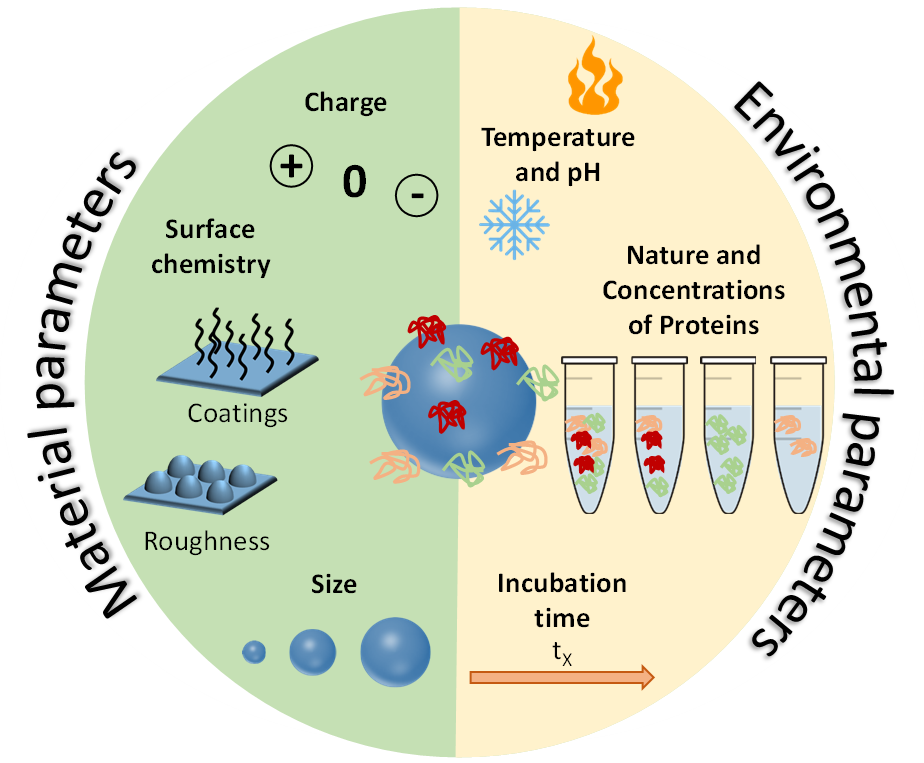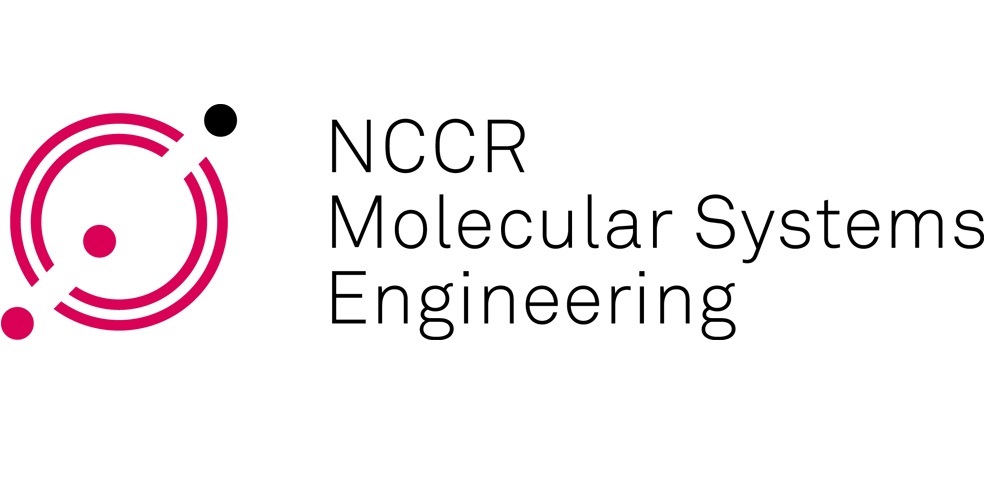Current projects
Bio-micro-device for understanding and control of nanoparticles blood interactions


2023-2026: EUR Project Micro-Nablorona
Role during the project: Project leader
This project aims to overcome the limitation of nanomedicine by developing a microfluidic device to accelerate the marketing of nanomedical solutions. During this project, a microfluidic device will be elaborated in collaborations with Femto-ST (Besançon, France) to analyze NPs in flow compared to classical in vitro assays in static.
The project will focus on blood interactions especially hemolysis and plasma proteins adsorption onto NPs.
The two main objectives of this project are:
1) Speed-up nanotoxiclogical tests and understandings of blood interactions of NPs
2) Optimize NPs developments.
more details
EUR grant from Région Bourgogne Franche-Comté
Collaborations: French center of blood donation (EFS), Hospitals of Dijon
PhD project of Ms. Aurora De La O Espadas (2023-2026)
Nanoparticles in blood: understanding and controlling protein corona for optimized nanomedicine


2022-2026: ANR JC/JC Nanoblorona
Role during the project: Project leader
The main goal of this project is to understand, control and optimize protein corona on NPs to avoid suffering random protein adsorption affecting the biomedical efficiencies of engineered NPs circulating in blood.
This project proposes a comprehensive study focused on NPs/proteins interactions in blood circulation in order to control their biological response
more details
Web page
ANR grant from Agence Nationale de la Recherche Scientifique
Collaborations: University of Geneva, Mulhouse Materials Science Institute (IS2M), CHU Dijon, CGFL
PhD project of Ms. Dorra Ben Elkadhi (2023-2026)
Articles:
Characterization Challenges of Self-Assembled Polymer-SPIONs Nanoparticles: Benefits of Orthogonal Methods
Identification of the Proteins Determining the Blood Circulation Time of Nanoparticles (more infos)
Understanding protein-nanoparticle interactions leading to protein corona formation: In vitro – in vivo correlation study
Up-conversion ferroelectric nanocrystal for optical sensing for electric potential in biological systems


2021-2024: ANR UFO
Role during the project: Member of WP3
Developing an optical nanosensor of extracellular potential in biological environment that transduces cell-related electrical changes (e.g. EAP in the case of neurons) into photoluminescence (PL) modifications relying on a mechanism never explored.
more details
Project leader F. Treussart ENS Paris-Saclay
Collaborations: Lumin Paris Saclay, SPMS Paris Saclay, SPEC Paris Saclay, METSY Paris
Article:
A Comprehensive Review on Barium Titanate Nanoparticles as a Persuasive Piezoelectric Material for Biomedical Applications: Prospects and Challenges
Completed projects
Completed Projects
Studies and understanding of proteins interactions with NPs’ surfaces


2019-2022: ANER: Nanoprot
Role during the project: Project leader.
This project focused on the in depth study and understanding of the parameters influencing the adsorption of proteins on the surface of nanoparticles of various parameters (surface chemistry, charges, shape, size…). We linked NP’s surface chemistry to biocirculation and platelet aggregation. This project was mainly done by the PhD student Célia Marets and in collaborations with the CGFL Dijon, University of Geneva, University George Washington and Stanford Medicine.
more details
Dr. Célia Marets PhD was funded by the EUR EIPHI and defended her thesis the 18/10/2023
Collaborations: University of Geneva, Stanford Medicine
Articles:
In vivo protein corona on nanoparticles: does the control of all material parameters orient the biological behavior?
Anti-Platelet Effect Induced by Iron Oxide Nanoparticles:Correlation with Conformational Change in Fibrinogen
Characterization Challenges of Self-Assembled Polymer-SPIONs Nanoparticles: Benefits of Orthogonal Methods
Titanate nanoribbon-based nanobiohybrid forpotential applications in regenerative medicine
Identification of the Proteins Determining the Blood Circulation Time of Nanoparticles (more infos)
Monitoring therapeutic cell treatments using novel nanoprobes.


2022: Collaborative Project France-Stanford
Role during the project: Project leader.
During a 2 months in 2022 visit I moved to Pr. Daldrup-Link Lab do explore the possibility of collaborations with Stanford Medicine. I was introduced to Magnetic Particle Imaging and work with Dr. M. Javad Hajiour on characterizations of NPs’ biological interactions.
more details
More information
Article:
Identification of the Proteins Determining the Blood Circulation Time of Nanoparticles (more infos)
Molecular Systems Engineering on the development of innovative molecular systems approaching the complexity of a cell.

2016: Swiss project NCCR (National Centers of Competence in Research)
Role during the project: Member of the project
Project description:

This NCCR project was pooling multidisciplinary areas from the physics and chemistry to the biology, the biostatistics and the computer sciences.
The main objctive of the « Molecular Systems Engineering » project was to create complex molecular layouts to mimic cellular reactions. Such systems can be use as organic molecules (enzymes for example) industrial productions or to control cellular systemps for applications in health.
Role during the project:
As a scientist in the WP 2 of University of Basel, my role was to develop stimulo-sensitive membranes made from the assembly of polymeric vesicles (polymersomes) and inorganic nanoparticles functionalized with DNA. These membranes shoul induce cascade reactions between the vesicles and catalyzed by the chosen nanoparticles (more details).
The NCCR project pooled 9 Swiss partners from academic and industrail fields:
- ETH Zürich
- EPFL
- Friedrich Miescher Institute
- IBM Research Zurich
- Paul Scherrer Institute
- University of Basel
- University of Bern
- University of Geneva
- University of Zürich
- WP 1: Molecular modules
- WP 2: Molecular systems
- WP 3: Molecular factories
- WP 4: Cellular systems
Development of nanotechnological tools for the detection and the therapy of arthrtic diseases.

2011-2014: FP7 European project (Nanodiara)
Role during the project: Co-project leader of WP1

Although treatment of rheumatoid arthritis (RA) has improved in the last years, there is still no disease modifying treatment for osteoarthritis (OA). For treatments to be effective it is considered extremely important to detect and treat these diseases early and then be able to monitor treatment efficacy early on (within weeks or months) after its initiation rather than waiting up to a year for RA and 18 months for OA. RA is a chronic inflammatory joint disease that involves acute and chronic synovial (joint lining) inflammation causing the erosive destruction of articular cartilages, ligaments and subchondral bone. It develops in about 1% of the population. OA, currently the main cause of disability among the middle age and elderly populations, is a degenerative arthritis involving much less synovial inflammation in most patients, with a prevalence of about 12%.
Role during the project:
As a scientist and WP leader at EPFL, my role was pivotal and consisted in bringing nanotechnological solutions to our biological, industrial and medical partners. As main responsibles of the WP 1, we worked in close collaborations with all the scientific WP to develop specific nanoparticles for arthritic pathologies with industrial requirements such as biocompatibility and upscalable methods to have enough quantity of materials for pharmacokinetic studies. We also studied in depth the biological behaviors of our nanohybrids (toxicity, internalization, biodistribution or Protein Corona).
The main objective of the NanoDiaRA project is the development of nanotechnology-based diagnostic tools for easy and early detection of disease onset, progression and responses to therapy RA and OA via specific targeting of inflammatory areas and imaging with Magnetic Resonance Imaging (MRI). New blood and urine nanotechnology-based diagnostic biomarker assays was also developed to be a very sensitive, easy to use and affordable immunoassay benchtop analytical systems for widespread clinical use. In view of the development of this targeted nanoparticle-based technology there are also opportunities to use this tissue-targeted approach for locally controlled drug release (e.g. in joints alone/intra-articular). This way of improving drug delivery to minimize possible side effects is a long term future approach which will be examined for its feasibility during the term of the project. The overall project follows a personalized medicine approach and is driven by the prominent unmet clinical needs outlined above.
Nanodiara pooled 15 European partners from academic and industrial fields:
- Coordinator: Europäische Akademie GmbH, Bad Neuenahr-Ahrweiler, Germany
- Scientific coordinator: MatSearch Consulting Hofmann, Lausanne, Switzerland
- Charité Universitätsmedizin (team 1 et team 2), Berlin, Germany
- EPFL, Lausanne, Switzerland
- University of Lund, Sweden
- Merck® Serono, Darmastadt, Germany
- AnaMar AB, Lund, Sweden
- Arrayon Biotechnology, Neuchâtel, Switzerland
- CSEM SA, Neuchâtel, Switzerland
- Merck Estapor/OEM-Diagnostic/Merck-Millipore, Pithiviers, France
- PMU Salzburg, Austria
- University of Fribourg, Switzerland
- University of Geneva, Switzerland
- University of Nijmegen, Netherlands
- University of Tartu, Estonia
The NanoDiaRA project is divided into five research work packages and four supporting work packages. While the research packages deal with fundamental research, the latter are particularly addressing dissemination, publication and valorization of the research outcome, investigation of the ethical issues, training of young investigators and the administration of the project.
WP 1: Particle coating and functionalisation and novel equipment for coating and separation
WP 2: Inflammation and tissue damage detection by cell and tissue tracking and molecular MRI based imaging
WP 3a: New Biomarker/ligand and antibody detection and development: targets, antibodies and peptides
WP 3b: New Biomarker/ligand and antibody detection and development: Clinical relevance
WP 4: Development of bioassays
WP 7: Toxicity
WP 5: Scientific Coordination and Data Management
WP 6: Ethical, Legal, and Social Aspects, Technology Assessment (ELSI)
WP 8: Dissemination of Results and Foreground, Communication, Education & Training
WP 9: Management



